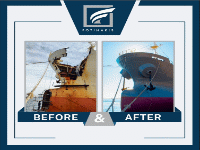MOL and Karpowership Plan to Convert Car Carrier to Floating Data Centers
Japan’s Mitsui O.S.K. Lines and Kinetics, an initiative from Karpowership, believe they have a concept to address the global shortage for data centers. Using the two companies' expertise, they are developing a plan to convert existing vessels into data centers that can be powered from mobile power or shore power to provide a quicker and more cost-efficient solution for data centers.
The development of AI and other technologies has created a dramatic demand for new data centers. Even in developed centers in Europe and the United States, it is outstripping the power supplies, forcing the data companies to look for creative solutions, from restarting the Three Mile Island nuclear power plant in the United States, and developing micro nuclear reactors to contracting for power from Europe’s offshore wind plants. MOL and Kinetics highlight that it can take five years before a new data center can become operational.
"By pairing mobile power generation with floating data infrastructure, we are addressing critical market bottlenecks while enabling faster, cleaner, and more flexible digital capacity expansion," said Mehmet Katmer, Chief Executive Officer of Kinetics.
The companies plan to complete this year a design feasibility study for converting existing vessels into offshore data centers. They will be working with data center operators and port authorities to develop the concept. MOL highlights that a car carrier has approximately 54,000 square meters of floor space, which would be equivalent to one of Japan’s largest land-based data centers.
The two companies will collaborate on the design, construction, and development of a state-of-the-art data center on a retrofitted vessel. They expect to be able to secure permits, licenses, and commercial contracts, so that a vessel conversion could begin in 2026. The conversion they project will be completed in one year, versus three years to build an onshore facility, and they expect to begin their first operations in 2027.
The concept calls for a 9,700 gross ton vessel that is 120 meters (394 feet) in length. It would use seawater or river water for cooling and likely be powered by a power ship alongside. They will also explore shore power connections. This concept would house a 20 to 72 MW data center, and potentially could be expanded using a modular configuration.
Other advantages they point to are the ability to relocate the data center based on changing demand. Also, it would not require the large amount of land required for a traditional data center, which is especially challenging in major metropolitan areas. By basing the center on an existing vessel, they will be able to repurpose the existing air conditioning, water, and generators to support the data center’s operations.
Karpowership, which was launched 30 years ago and is part of the Karadeniz Energy Group, reports that it today has more than 7,000 MW installed capacity globally. It has projects or is pursuing developments ranging from Africa to Brazil, New Caledonia, and the Dominican Republic.
MOL reports it has a fleet of approximately 100 car carriers. The company is building a new generation of larger vessels powered by LNG. The project represents a creative reuse of vessels within its fleet.
Content Original Link:
" target="_blank">




















































